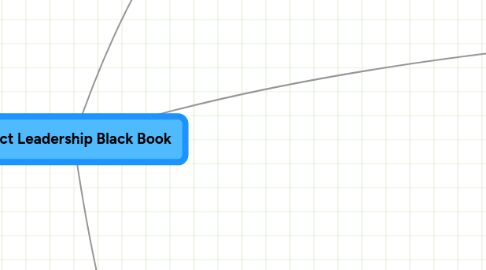
1. Leading
1.1. Principles, Paradoxes & Conceits
1.1.1. Stockdale Paradox
1.1.1.1. Embracing the brutal reality of the moment
1.1.1.2. Unshakeable belief in the vision
1.1.2. Influence Paradox
1.1.2.1. Elegant at influencing
1.1.2.2. Sceptical in being influenced
1.1.3. Projects don't happen in a box
1.1.3.1. The extended and diverse stakeholder group
1.1.3.1.1. Who are they?
1.1.3.1.2. The people in the middle
1.1.3.1.3. Telling stories
1.1.4. Context and State dependence
1.1.5. Leadership is there whether you are doing it or not
1.1.6. Politics are there whether you participate or not
1.1.7. Mass movements grow, they don't happen wholesale
1.1.8. It's impossible to fully comprehend the system you are changing.
1.1.8.1. Beaufortes Cube
1.1.9. Communicate Paradox: Simplicity beyond complexity
1.1.9.1. Simple messages required for audience
1.1.9.1.1. attention scarcity
1.1.9.1.2. large numbers
1.1.9.1.3. cognitive limits
1.1.9.2. Complex subject domain
1.2. How to lead
1.2.1. It's not about personality
1.2.1.1. Preferred type
1.2.1.2. Capability to act
1.2.2. The myth of team types
1.2.3. How to elicit team behaviours
1.2.3.1. What are team behaviours?
1.2.4. Mobilisation phase
1.2.4.1. Recruit for attitude, not experience
1.2.4.2. Often worth waiting for the right resource
1.2.5. Forming, storming, norming, performing, reforming
1.2.6. Avoiding Acceptable Underperformance
1.2.7. Who is the leader?
1.2.7.1. Imprinting?
1.2.7.2. Delegation
1.2.7.3. You are, are you?
1.2.7.4. The Bid For Power moment
1.2.7.5. What to do if you're not the leader
1.2.8. Communicating with influence
1.2.8.1. Building motivation through engagement
1.2.8.2. Building emotional content
1.2.8.3. Creating a model of the world that motivates while fitting-in with concious concepts of the project
1.2.8.4. Cialdini's findings
1.2.8.5. Multi-media and experiential
1.2.8.5.1. Gettysbury Powerpoint
1.2.8.6. Viral nature of communications
1.2.9. Leading the Project sub-culture
1.2.9.1. Start visibly with team meetings
1.2.9.2. The power of the unconscious and harnessing the subliminal.
1.2.9.3. Getting the team off the treadmill
1.2.9.4. Triple whammy
1.2.9.4.1. Concept
1.2.9.4.2. Meaning - engagement
1.2.9.4.3. Story - experience
1.2.9.5. Conditioning of emotions in a way that people put in discretional effort on behalf of the project
1.2.10. Leader as facilitator
1.2.11. Dammit! Where's that constraint gone?
1.2.12. How decisions are made
1.2.12.1. Dictator
1.2.12.2. Consultative Dictator
1.2.12.3. Collegiate
1.2.12.4. Vote
1.2.12.5. Engineered decision (Keppner Trego / Weighting Rating
1.2.12.6. Scientific process - a comment
1.2.12.7. Fate
1.2.12.8. When to make the decision
1.2.12.9. Assessing decision quality
1.2.12.10. Strangers to ourselves
1.2.12.10.1. Errors in human judgement
1.2.12.10.2. The power of "how do we know"?
1.2.13. Feedback and conditioning
1.2.13.1. Operant
1.2.13.1.1. PIC NIC
1.2.13.2. Pre-operant
1.2.13.3. Associative
1.2.14. Political savvy
1.2.14.1. The Drama Triangle & Transaction Analysis
1.2.14.2. Crucial conversations
1.2.14.3. Upgrading your Organisational Bullshit Detector
1.2.14.4. Pro-active politick suppression
1.2.14.5. Negotiation skills
1.2.14.5.1. Techniques
1.2.15. Valuing knowledge and availability
2. Introduction
2.1. Our story
2.2. The Time for Project Leadership
2.2.1. Knowledge workers
2.2.1.1. Leave with valuable resources
2.2.1.2. Unable to monitor time effort
2.2.2. Project Ubiquity
2.2.2.1. The rise of the project
2.2.2.2. From Unreason to Engagement
2.2.3. Project Management Is Failing
2.2.3.1. The failings of project management
2.2.3.2. Our rejection of project management
2.2.3.3. Management de-motivation
2.2.4. Large scale change starts with small projects
2.2.4.1. Cumulative effect
2.2.4.2. A built capability
2.2.4.3. Culture change as a legacy of powerful project subcultures
3. Project Leadership Activities by Phase
3.1. Overview
3.1.1. Project Process - Overview
3.2. Initiation Phase
3.2.1. Business Case
3.2.2. Engagement case
3.2.2.1. Story
3.2.2.2. Frame
3.2.3. Do's and Don'ts in the project era
3.2.3.1. Methodologies
3.2.3.2. Quality assurance
3.2.3.3. Triple boxing
3.2.3.4. Is it big enough for you?
3.2.3.5. Is it hairy enough for you?
3.2.3.6. Change management is a set of techniques, not a methodolgy
3.2.3.7. Six Sigma?
3.2.4. Project Charter
3.2.4.1. Key question
3.2.5. Project Initiation Checklist
3.2.6. Project Organization Chart
3.2.7. Project Scope and Business Objectives
3.2.8. Project types: concrete to abstract
3.3. Delivery Phase
3.3.1. Design
3.3.2. Build
3.3.3. Test
3.3.4. Change Request
3.3.5. Track Issues
3.3.6. Project Status Report
3.3.7. Quality Review Meeting
3.3.8. Quick Status Report
3.3.9. Steering Committee Meeting
3.3.10. Resource constraints
3.3.11. Point of no return
3.3.12. Risk based approach
3.3.13. Iterations
3.3.14. Modern practices in the InterWeb 2.x era
3.3.14.1. Project tools
3.3.14.2. Crowdsourcing
3.3.14.3. Virtual teams
3.3.14.4. Mash-ups
3.3.14.5. Partnering
3.3.14.6. Shotgun partnering
3.4. Closing Phase
3.4.1. Project Closure Report
3.4.2. It's a people issue
3.4.3. The other point of no return (post natal!)
3.5. Operate
3.5.1. The Project Ready Organisation
3.5.1.1. Executive Level Program Management
3.5.1.2. Communicate the organisations priorities when resource constraints occur
3.5.1.3. Lean means not available
3.5.1.4. Project performance is included in annual review
3.5.1.5. If it isn't ready, this is your problem.
3.5.1.5.1. Internal networking and "priming the pump".
3.5.1.5.2. Tools for internal networking
3.5.1.6. Work / Life balance, fairness and other bollocks out of the mouths of adults.
3.5.2. Working alongside on-going operations
3.5.3. Interrelationships of programs and projects; portfolio project management
